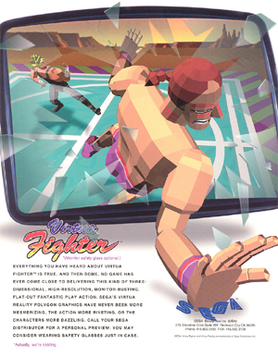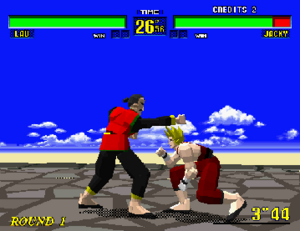Virtua Fighter (video game) facts for kids
Quick facts for kids Virtua Fighter |
|
|---|---|

North American arcade flyer
|
|
| Developer(s) | Sega AM2 |
| Publisher(s) | Sega |
| Director(s) | Yu Suzuki Hideki Anbo (32X) |
| Producer(s) | Yu Suzuki Kouchi Nagata (32X) |
| Designer(s) | Seiichi Ishii Yoshinao Asako, Youji Kato, Ryoya Yui (Saturn) Masashi Kubo (32X) |
| Programmer(s) | Toru Ikebuchi Keiji Okayasu (arcade & Saturn) Hiroaki Shoji Eiji Horita, Akio Setsumasa, Tatsuo Yamajiri, Yasuhiro Takahashi (32X) |
| Composer(s) |
Takayuki Nakamura
Arcade
Takayuki Nakamura Saturn sound design Takayuki Nakamura Takenobu Mitsuyoshi Kazuhiko Kouchi 32X sound design Masaru Setsumaru Tatsuya Kohzaki Atsumu Miyazawa Tadashi Joukagi |
| Series | Virtua Fighter |
| Platform(s) | Arcade, Saturn, 32X, R-Zone, Windows |
| Release date(s) | Arcade
|
| Genre(s) | Fighting |
| Mode(s) | Single-player, multiplayer |
| Arcade system | Model 1, ST-V (Remix) |
Virtua Fighter is a fighting game created for the Sega Model 1 arcade platform by AM2, a development group within Sega, headed by Yu Suzuki. An early prototype version was location tested in Japan by August 1993, before the complete game was released worldwide in October 1993. It is the first game in the Virtua Fighter series, and the first arcade fighting game to feature fully 3D polygon graphics. The game has been ported to several platforms including the Sega Saturn, Sega 32X, and Microsoft Windows.
The game was critically acclaimed and a major hit, becoming one of Sega's best-selling arcade games of all time with more than 40,000 arcade units sold while the Saturn versions sold over 1 million copies. Virtua Fighter was highly regarded for its in-depth 3D fighting engine and real-world fighting techniques, and has been revolutionary and highly influential in the evolution of the genre and video games in general.
An update titled Virtua Fighter Remix, developed by AM1, was released for the Saturn in 1995, and ported to the arcade later that same year. The game's remake, Virtua Fighter 10th Anniversary, was released for the PlayStation 2 in 2003 as a stand-alone title in Japan and as a bonus to Virtua Fighter 4: Evolution in North America.
Contents
Gameplay
The Virtua label indicates that the onscreen action takes place in a 3D environment, however movement was restricted to 2D. The images were created using wireframe and flat-shaded quad polygons. Beyond 3D, it retained the staple of multiple characters, each with their own distinctive moves.
In the game's single-player mode, the player faces all eight characters (including a duplicate of the chosen character) in a pre-determined order, followed by a fight with the game's boss, Dural. Each fight is a best-of-three match, and the player has three ways to win: knocking out the opponent, forcing them out of the ring, or having more health left when time runs out.
Unlike other fighting games of the early 1990s (such as Street Fighter II or Mortal Kombat), the game relies on a control stick and only three buttons, punch, kick, and guard (block) although different situations and button combinations led to a vast variety of moves for each character.
Plot
Characters
- Akira Yuki—An assistant kung fu teacher from Japan, fights with Bajiquan.
- Pai Chan—A martial arts film star from Hong Kong, fights with Mizongquan.
- Lau Chan—Pai's father and a cook from China, fights with a fictional fighting style Hǔ Yàn Quán (虎燕拳, Koen-ken, "Tiger Swallow Fist").
- Wolf Hawkfield—A professional wrestler from Canada, fights with professional wrestling maneuvers.
- Jeffry McWild—A fisherman from Australia, fights with Pancratium.
- Kage-Maru ("Kage")—A ninja from Japan, fights with Jujutsu.
- Sarah Bryant—A college student from San Francisco, CA who had been abducted and brainwashed by a criminal organization, fights with Jeet Kune Do (Sega changed her fighting style to "martial arts", which also includes Tae Kwon Do, Savate and Karate as of Virtua Fighter 4: Evolution).
- Jacky Bryant—Sarah's older brother and a race car driver also from San Francisco, fights with Jeet Kune Do.
- Dural—A gynoid that is the game's boss character and is Kage's missing mother, Tsukikage. She fights with a mix of all the other characters' styles.
An Arab fighter named Siba was planned, and his character model appeared on some Virtua Fighter arcade cabinets (though, in some cases, Akira's name was placed under his portrait). Siba was originally to be the protagonists of the franchise. He was ultimately dropped, but later appeared in Fighters Megamix. Two other characters were also discovered. One of which was an early design of Akira Yuki. The other was a military man named Jeff.
Story
Once in the Shōwa period, the defunct Japanese army intended to approach Henry Pu-yi, the last Emperor of the Ching Dynasty in their effort to take advantages. However, they were defeated by the Imperial guards who used the martial art called Hakkyoku-ken. During World War II, the Japanese army research the mysteries of Hakkyoku-ken to create supersoldiers, developing the ultimate martial art.
Approximately half a century has passed since then, the ultimate World Fighting Tournament is about to start, and all kinds of fighters from around the world engage to determine the world's best. Behind the Tournament, however, there exists an intrigue designed by a sinister syndicate.
Development and release
Virtua Fighter
The game's development began in 1992, following the development of Virtua Racing. Virtua Fighter was developed to run on Sega Model 1 arcade hardware, developed internally at Sega. According to Sega of Japan's publicity manager, Kurokawa, "We deliberately didn't publicize all the [fighting] moves at the same time but instead revealed them to gamers one at a time by means of the Japanese videogame press." Virtua Fighter also used 3D motion capture technology.
According to Suzuki, an issue during the game's development was performing fast division calculations for 3D operations. The only applications he was aware of performing fast enough divisions at the time were nuclear reactors and space rockets. The team "were working away with craftsmanship equivalent to inscribing 100 words on a single grain of rice" to achieve fast 3D division operations, according to Suzuki.
An early prototype version of the arcade game featured an Arab fighter called Siba. This early version did not have Akira Yuki, who was added later in development as a replacement for Siba, with Akira becoming the game's protagonist. This early prototype version was location tested in Japan and then demonstrated at the Amusement Machine Show (AM Show) in August 1993.
Virtua Fighter was a launch game for the Sega Saturn, and served as the pack-in launch game in North America. Its Sega 32X version was developed by the same team responsible for the Genesis port of Virtua Racing.
Virtua Fighter Remix
Virtua Fighter Remix was an update of the original Virtua Fighter with higher-polygon models, texture mapping, and some gameplay changes. It was given free to all registered Saturn owners in the United States via mail. It had an arcade release on the ST-V (an arcade platform based on the Sega Saturn) and later ported to Microsoft Windows as Virtua Fighter PC. In Japan, Game Machine listed it on their August 1, 1995, issue as being the twenty-first most-successful arcade game of the month.
Virtua Fighter 10th Anniversary
With the 2003 PlayStation 2 release of Virtua Fighter 4: Evolution arriving in time for the series' 10th anniversary, a remake of Virtua Fighter, Virtua Fighter 10th Anniversary, was released on the PlayStation 2. While the music, stages, and low-polygon visual style were retained from the first game, the character roster, animations, mechanics, and movesets were taken from Evolution. In the previous PS2 release of Virtua Fighter 4, a button code would make the player's character look like a Virtua Fighter model. In Japan, the game was included as part of a box set with a book called Virtua Fighter 10th Anniversary: Memory of a Decade and a DVD. The box set was released in November 2003 and was published by Enterbrain. In North America, the game was included in the home version of Virtua Fighter 4: Evolution, and in Europe it was only available as a promotional item; it was not sold at retail.
Legacy and impact
- Further information: Virtua Fighter
Virtua Fighter dispensed with sprite-based graphics, replacing them with flat-shaded polygons rendered in real-time, by the Model 1's 3D-rendering hardware, allowing for effects and technologies that were impossible in sprite-based fighters, such as characters that could move in three dimensions, and a dynamic camera that could zoom, pan, and swoop dramatically around the arena. It has been credited with both introducing and popularizing the use of polygon-based 3D graphics in fighting games. Next Generation said in 1995 that Virtua Fighter was "arguably the most significant game" of the 1990s. 1UP listed it as one of the 50 most important games of all time. They credited Virtua Fighter for creating the 3D fighting game genre, and more generally, demonstrating the potential of 3D polygon human characters (as the first to implement them in a useful way), showing the potential of realistic gameplay (introducing a character physics system and realistic character animations), and introducing fighting game concepts such as the ring-out and the block button.
At a time when fighting games were becoming increasingly focused on violence and shock value, the popularity of Virtua Fighter demonstrated that fighting games focused on gameplay were still commercially viable. Nintendo's Shigeru Miyamoto said that for several years after Virtua Fighter was released he was disinterested in making fighting games because he felt that "I was beaten to the punch when Virtua Fighter came out", and that any fighting game he produced would have been perceived as an attempt to copy Virtua Fighter. Game designer Yasuyuki Oda remarked that he was impressed by this video game while working for SNK. In particular, Virtua Fighter garnered praise for its simple three-button control scheme, with the game's strategy coming from the intuitively observed differences between characters that felt and acted differently rather than the more ornate combos of two-dimensional competitors. Virtua Fighter's fluid animation and relatively realistic depiction of distinct fighting styles gave its combatants a lifelike presence considered impossible to replicate with sprites.
Virtua Fighter played a crucial role in popularizing 3D polygonal graphics. Some of the Sony Computer Entertainment (SCE) staff involved in the creation of the original PlayStation video game console credit Virtua Fighter as inspiration for the PlayStation's 3D graphics hardware. According to SCE's former producer Ryoji Akagawa and chairman Shigeo Maruyama, the PlayStation was originally being considered as a 2D focused hardware, and it was not until the success of Virtua Fighter in the arcades that they decided to design the PlayStation as a 3D focused hardware. Toby Gard also cited Virtua Fighter as an influence on the use of polygon characters—and the creation of Lara Croft—in Tomb Raider: "It became clear to me watching people play Virtua Fighter, which was kind of the first big 3D-character console game, that even though there were only two female characters in the lineup, in almost every game I saw being played, someone was picking one of the two females." John Romero also cited Virtua Fighter as a major influence on the creation of 3D first-person shooter Quake. Team Ico's Fumito Ueda also cited Virtua Fighter as an influence on his animation work.


